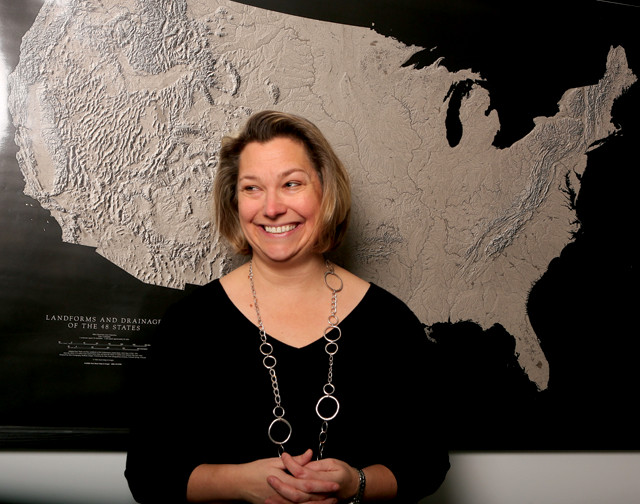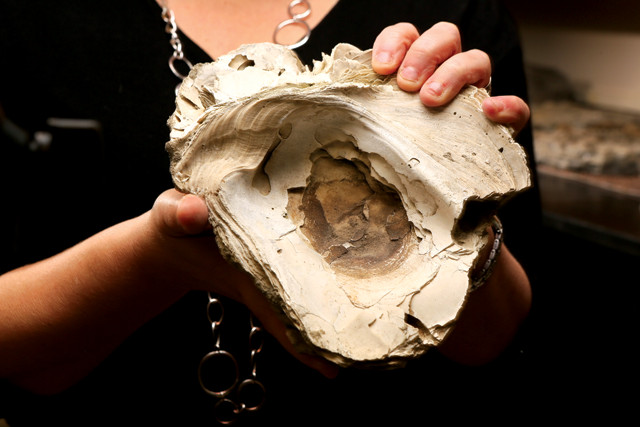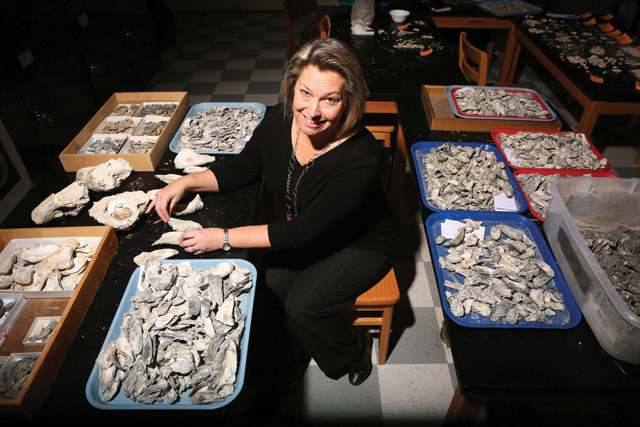
by Alison F. Takemura Tuesday, July 3, 2018

Rowan Lockwood, a professor of paleobiology in the Department of Geology at the College of William and Mary in Virginia, studies ecological changes through geologic time to inform modern conservation approaches. Credit: Stephen Salpukas.
In 1608, Captain John Smith noted that oysters “lay as thick as stones” on the floor of the Chesapeake Bay. The shell reefs — built up by hundreds of years of oyster generations — were so large, ships wrecked against them. And each oyster was so massive, to eat one, you had to cut it into pieces — like a steak.
“This was what a truly healthy [oyster] reef looked like,” says Rowan Lockwood, a paleobiologist at the College of William and Mary in Virginia. “People today have never actually seen one in the Chesapeake Bay.”
Before colonization by Europeans, bigger and more densely packed oysters dominated the Chesapeake. But where 4,000 oysters used to crowd a square meter, Lockwood says there are now only about 200 in the same space. Oysters also used to reach a venerable old age. By counting layers in fossilized shells — akin to tree rings — Lockwood’s team has found that oysters historically lived up to 25 years. Today, the bay has few oysters older than 5 years.
Conservation efforts need a new approach, according to Lockwood. The current focus is mainly on distributing oyster larvae, which are raised in tanks and then sprinkled over dead oyster shells in the wild to encourage the larvae to settle on a hard surface — a necessary step for a larva to survive. But Lockwood thinks those efforts miss their mark by focusing on such young oysters, which have a one-in-a-thousand chance of survival, rather than promoting the conservation of oysters several years old, which can each produce a thousand larval settlers every reproductive season.
“Where are you going to put your money?” Lockwood asks. Funding is limited — and precarious. The federal government has financially supported efforts to clean up the Chesapeake watershed since 1983. The Environmental Protection Agency’s Chesapeake Bay Program provides $73 million annually for such efforts, including renewal of oyster populations, to the six states in the watershed — Delaware, Maryland, New York, Pennsylvania, Virginia and West Virginia — as well as the District of Columbia. But the program is at risk of being downsized, including a potential 90 percent reduction in funding for fiscal year 2019.

Before the 1880s, when people began to dredge oysters, some of the mollusks grew to gargantuan sizes — up to about 30 centimeters. Credit: Stephen Salpukas.
That financial blow, if Congress were to approve it, would come as Lockwood and her team are unearthing striking evidence of the Chesapeake’s mollusk-rich past. The research suggests a tantalizing picture of what the bay once was, she says, and what it could be again with sensible conservation efforts.
Lockwood recently sat down with EARTH to talk about the heyday of Chesapeake oysters, their current plight, and dipping her toe into new waters: recommending policy.
AT: Can you describe a fossilized reef you study?
RL: One on the Piankatank River [in Virginia] is my favorite. At low tide, you can see the whole reef — about 2.5 meters tall and 40 meters long. It was laid down probably about 250,000 years ago, when the Piankatank was a lot saltier. It has huge oysters; I think the biggest I’ve seen there is about 30 centimeters long. The oysters are all preserved in life positions, so it looks like they died yesterday. They’re laid sort of along two orientations: one is parallel to the Piankatank River itself, and the other is parallel to the Chesapeake Bay. These are in the tidal channels, the faster-flowing parts of the river. Oysters love to be in fast waterflows, because they can get lots and lots of food that they can run over their gills. So, in the reef, you can see that their orientations line up with where the food’s moving back and forth.
AT: How can studying the geologic past help Chesapeake Bay conservation today?
RL: I’m a strong believer in the idea that if you don’t study history, you are doomed to repeat it — I think that holds true in the fossil record just as it holds true in human history. Much of our data on biology or ecology only goes back maybe 70 or 80 years. That’s just a tiny blink of an eye in terms of how long life’s been around. If you want to understand how biology works, you can’t just study biology today — you have to study hundreds of millions of years of it. Otherwise, it would be a bit like trying to argue that you want to study history by studying just the last 10 years. You’d be really limiting yourself.
AT: Why are oysters in the bay smaller today than in the past?
RL: The oyster size really didn’t start dropping until the Colonial Era. The Native Americans were harvesting oysters mainly by hand; that was a slow-enough rate that they were able to maintain it sustainably.
When Europeans came on the scene, we see a slow decline [in the historic record] in oyster size and abundance — until we invented dredging in the 1880s. Dredging’s basically when you pull a big rake along the seafloor. We rake much, much faster than oysters can grow. Once we had developed dredging technology, the oysters basically tanked.

Lockwood samples ancient oyster beds like this one found on the banks of the Piankatank River in Virginia. Credit: Rowan Lockwood.
AT: What does dredging do to the reef ecosystem?
RL: Ecologically speaking, what we did in the Chesapeake Bay was essentially the equivalent of dredging all the coral off the Great Barrier Reef. There’s a knock-on effect. A lot of organisms that lived on those oyster reefs are now suffering as a result [of dredging]: juvenile fish species that would have used those reefs as protection from predators; different kinds of invertebrates — like snails and clams, worms, barnacles — that would have attached to them; and starfish that would have lived in and around them. We’ve really shifted from a bottom of the bay that had these patchy oyster reefs, to a bottom of the bay that’s just mud. There are lots of critters that live in mud. But not the full diversity we need to keep the bay healthy, especially if we want to keep fishing and harvesting.
AT: Why does oyster size matter?
RL: Oysters are sequential hermaphrodites: They’re all born male, and they transition into female when they reach a certain size. If we’re missing the larger members of the oyster population today, we’re preferentially missing females. And it gets worse. It turns out that an oyster’s shell size is directly correlated to reproductive output. So, the bigger you are, the more offspring you have. Once again, if we’re missing these larger oysters, we’re missing the reproductively more active oysters as well.
AT: How do oysters contribute to the health of the bay?
RL: Oysters feed by filtering tiny particles out of the water column, including organic matter, pollutants, sediment and everything in between. So, by feeding, they are literally filtering the bay. About 20 years ago, an oyster biologist estimated that at the height of the oyster [population], in the 1700s and 1800s, it took only three days for all the water in the Chesapeake Bay to go through the gill of an oyster. And now that estimate is closer to 180 days.
AT: You recently became involved with policy. What are some of your policy recommendations for the bay?
RL: To protect these larger oysters, the most effective approach is going to be to establish large, long-term sanctuaries. Oyster sanctuaries today are relatively small. They’re in some of the poorer quality habitats and they’re usually only protected for a year or two in a given spot. [Instead], we need to really be thinking about long-term sanctuaries on the scale of an oyster’s lifespan — on the order of decades.
I don’t think it’s politically viable to suggest we stop fishing the oysters. What I’m talking about, you wouldn’t even have to increase the area [of sanctuaries]; you would just have to stop moving them around and leave them for a substantial period of time.

Lockwood sits among some of the many oysters collected from the Chesapeake Bay, which she uses to reconstruct past reef ecology and assess current oyster health in the region. Credit: Stephen Salpukas.
AT: What are some of the challenges to setting aside long-term sanctuaries?
RL: Creating sanctuaries is a straightforward idea, but the concept of a long-term ban on harvesting, even in a very small part of the bay, is controversial. Watermen are concerned that the short-term consequences of sanctuaries (i.e., a likely decrease in harvests for two to three years) outweigh the long-term benefits (i.e., an increase in harvests for the future). Oysters provide the livelihood for dozens of families that have been harvesting in the bay for generations. So, there is a sociocultural tradition here that we need to be mindful and respectful of. At the same time, we’re trying to keep the Chesapeake Bay healthy for everyone, not just one small group.
AT: Oysters in the bay are facing two widespread diseases, commonly known as MSX and Dermo. Could sanctuaries do anything to reduce the spread of these diseases?
RL: In parts of the bay that are heavily polluted, where you’re not allowed to harvest at all because the oysters are effectively toxic, you can find larger and longer-lived oysters — some of which are starting to develop tolerance to MSX and Dermo. It’s not the same as disease resistance, but they’re becoming more tolerant. We’ve been spending a lot of funding to breed disease-resistant oysters in the lab; we haven’t been very successful, but natural selection is doing it for us — by allowing individuals that evolve disease tolerance to survive, reproduce and pass along their genes for disease tolerance to the next generation. This, to me, suggests that we need to establish long-term sanctuaries where oyster disease tolerance can spread and let natural selection do its thing.
AT: What sort of policy-related outreach have you done?
RL: I [recently] gave a presentation at the Virginia Institute of Marine Science to folks who do oyster monitoring, and there was a lot of excitement about applying the same kind of numerical modeling that they apply to modern populations to the ancient oyster populations I study to better understand growth and reproductive rates in longer-lived oysters. The conversation with state agencies hasn’t gone quite as fast. But we’re talking a lot with people who have boots on the ground — who are doing the population monitoring and the disease monitoring.
AT: What do you hope your research and advocacy will have accomplished 20 years from now?
RL: I would love to convince managers to take a long-term outlook on this [conservation issue] — both looking far back into the past to see what a healthy oyster reef looks like, but then also planning far into the future, for my daughter and her generation. I would be thrilled if we had even three to four larger, long-term sanctuaries in both Virginia and Maryland.
© 2008-2021. All rights reserved. Any copying, redistribution or retransmission of any of the contents of this service without the expressed written permission of the American Geosciences Institute is expressly prohibited. Click here for all copyright requests.